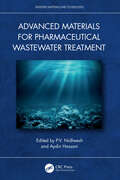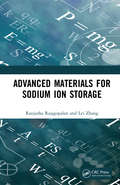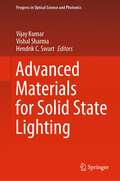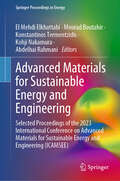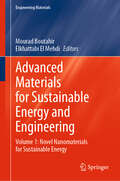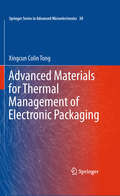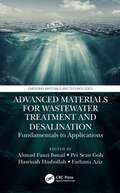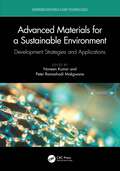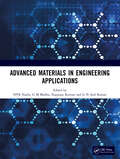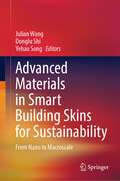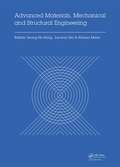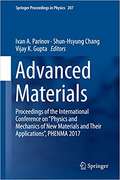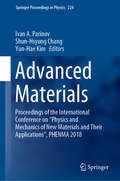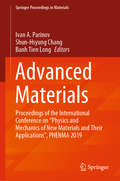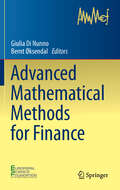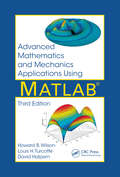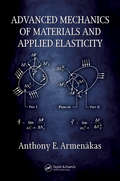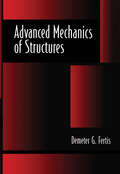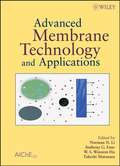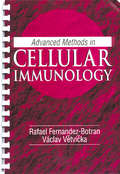- Table View
- List View
Advanced Materials for Pharmaceutical Wastewater Treatment (Emerging Materials and Technologies)
by P. V. Nidheesh Aydin HassaniEffluents generated from the pharmaceutical industry contain organic and inorganic contaminants that create potential threats to human health and the environment. Pharmaceuticals cannot be effectively removed by conventional wastewater treatment plants owing to the complex composition, high concentration of organic contaminants, high salinity, and biological toxicity of pharmaceutical wastewater. This book provides an overview of the production and environmental impacts of pharmaceutical compounds and their advanced treatment methods, with a focus on advanced materials used for removing pharmaceutical contaminants from wastewater. Provides an overview of the current state of advanced research and applications of materials for pharmaceutical wastewater treatment Discusses various adsorbents, photocatalysts, and electrodes, with a special focus on carbon materials Covers advanced material synthesis and fabrication Features case studies and chapters that are fully application-oriented This book is essential reading for researchers and practitioners in materials science and engineering, environmental science and engineering, chemical engineering, and water treatment who are seeking to develop and implement advanced technologies for waste minimization and mitigation.
Advanced Materials for Sodium Ion Storage
by Lei Zhang Ranjusha RajagopalanGlobally, lithium ion batteries (LIBs) are leaders in the energy storage sector but there are concerns regarding load leveling of renewable energy sources as well as smart grids and limited availability of lithium resources resulting in cost increase. Therefore, sodium ion batteries (SIBs) are being researched as next-generation alternatives to LIBs due to their similar sustainability and electrochemistry. This book mainly focuses on the current research on electrode materials and proposes future directions for SIBs to meet the current challenges associated with the full cell aspect. Further, it provide insights into scientific and practical issues in the development of SIBs.
Advanced Materials for Solid State Lighting (Progress in Optical Science and Photonics #25)
by Vijay Kumar Vishal Sharma Hendrik C. SwartThis book highlights the synthesis, luminescence, and applications of rare earth-doped phosphors materials for solid-state lighting. Solid-state lighting is turning into a leading technology in the lighting industry, permitting improvement in the fields from architectural to domestic applications. Driven with the aid of using ongoing multi-field research, solid-state lighting needs an improvement of various technologies: efficient and reliable light-emitting devices, devices for new functionalities, and optical solutions for beam shaping. Noteworthy research endeavors were aimed to find out eco-friendly, better performance, cost, and energy-efficient phosphor materials for the application in solid-state lighting devices. Power phosphor materials with advanced optical and photoluminescence properties in a wide range of areas have shared the research efforts in this sector aimed in the direction of achieving better material features. Rare earth ion-doped phosphor materials have been the subject of scientific interest because of their significant applications in a variety of fields such as display devices, temperature sensors, solar cells, bio-imaging, and optoelectronics devices. This book covers the broad aspects of organic and inorganic materials based on phosphor materials and is beneficial to researchers involved in these areas. This book is specially designed to provide an introductory concept of luminescent materials, particularly man-made (artificial) phosphors in a language comprehensible to beginners and students. The book also includes some new materials with promising technologies and upgraded properties that expose new potential possibilities are also highlighted.
Advanced Materials for Sustainable Energy and Engineering: Selected Proceedings of the 2023 International Conference on Advanced Materials for Sustainable Energy and Engineering (ICAMSEE) (Springer Proceedings in Energy)
by Konstantinos Termentzidis El Mehdi Elkhattabi Mourad Boutahir Kohji Nakamura Abdelhai RahmaniThis book presents selected peer-reviewed proceedings from the International Conference on Advanced Materials, Sustainable Energy, and Engineering (ICAMSEE2023), held at Ecole Normale Supérieure, University Moulay Ismail Meknes, Morocco, from November 27 to 29, 2023. The conference served as an exceptional platform for international and national scientists, professors, students, and industry professionals to convene and exchange knowledge in the fields of materials science, microscopy, engineering, technology, and energy. The book features contributions from researchers and experts, including keynote speakers, special sessions, posters, and tutorials, showcasing the latest advancements and developments in these areas of research.The topics covered in this book span a wide array of subjects within the realm of advanced materials, sustainable energy, and engineering. The forefront of materials science is explored, including nanomaterials, carbon nanotubes, graphene,materials for various applications, environmental protection, advanced optical materials, thermoelectric and magnetic materials, and additive manufacturing. Addressing the energy demands of today, the focus extends to novel materials for solar cells, energy storage, electronic devices, solar and wind energy, advanced thermal management materials, and materials for advanced water treatment and desalination. Sustainable energy and engineering topics encompass energy policy, clean energy production technologies, carbon capture and utilization, biomass energy, building energy efficiency, smart systems for climate change, and energy efficiency in mineral processing. Additionally, the book covers modeling and numerical simulations in material science, encompassing model development, computational techniques, and simulations in both material science and energy fields.
Advanced Materials for Sustainable Energy and Engineering: Volume 1: Novel Nanomaterials for Sustainable Energy (Engineering Materials)
by Mourad Boutahir Elkhattabi El MehdiThis book delves into the realm of sustainable energy and presents a comprehensive analysis of novel nanomaterials with potential applications in this field. Each chapter offers a unique perspective, contributing to the understanding and development of advanced energy materials. From the infrared spectroscopy analysis of boron nitride nanotubes to the investigation of optical properties of ZnO thin films and the study of double perovskite oxides, this collection covers a wide range of topics. It explores iron-based nitrides, phase change materials for smartphones, thermochromic glazing with vanadium dioxide, and the influence of magnetic pressure on smart materials. The physical properties and applications of 2D phosphorene, carbon nanotube interactions, and metalloporphyrin-encapsulated carbon nanotubes are also discussed. Moreover, the collection investigates the thermal and phonon properties of carbon nanomaterials, optoelectronic properties of perovskite materials, and the physical properties of phosphorene nanotubes. Featuring extended chapters selected as exceptional contributions to the 2023 International Conference on Advanced Materials for Sustainable Energy and Engineering in Meknes, Morocco, this book provides researchers and practitioners with a comprehensive overview of some of the latest advancements in novel nanomaterials. With its interdisciplinary approach and rigorous scientific analysis, this edited collection serves as a valuable resource for those striving to develop sustainable energy solutions for the future.
Advanced Materials for Thermal Management of Electronic Packaging (Springer Series in Advanced Microelectronics #30)
by Xingcun Colin TongThe need for advanced thermal management materials in electronic packaging has been widely recognized as thermal challenges become barriers to the electronic industry's ability to provide continued improvements in device and system performance. With increased performance requirements for smaller, more capable, and more efficient electronic power devices, systems ranging from active electronically scanned radar arrays to web servers all require components that can dissipate heat efficiently. This requires that the materials have high capability of dissipating heat and maintaining compatibility with the die and electronic packaging. In response to critical needs, there have been revolutionary advances in thermal management materials and technologies for active and passive cooling that promise integrable and cost-effective thermal management solutions. This book meets the need for a comprehensive approach to advanced thermal management in electronic packaging, with coverage of the fundamentals of heat transfer, component design guidelines, materials selection and assessment, air, liquid, and thermoelectric cooling, characterization techniques and methodology, processing and manufacturing technology, balance between cost and performance, and application niches. The final chapter presents a roadmap and future perspective on developments in advanced thermal management materials for electronic packaging.
Advanced Materials for Wastewater Treatment
by Shahid Ul-IslamOver the past few decades, rapid industrialization, fast urban encroachment, and improved agricultural operations have introduced substantial amounts of potentially toxic organic substances into the atmosphere and into the aquatic and terrestrial environments. Advanced Materials for Wastewater Treatment brings together innovative methodologies and research strategies to remove toxic effluents from wastewaters.With contributions from leading scientists from all around the world, the book provides a comprehensive coverage of the current literature, up-to-date overviews of all aspects of toxic chemical remediation including the role of nanomaterials.
Advanced Materials for Wastewater Treatment and Desalination: Fundamentals to Applications (Emerging Materials and Technologies)
by Ahmad Fauzi Ismail Pei Sean Goh Hasrinah Hasbullah Farhana AzizAdvanced Materials for Wastewater Treatment and Desalination: Fundamentals to Applications offers a comprehensive overview of current progress in the development of advanced materials used in wastewater treatment and desalination. The book is divided into two major sections, covering both fundamentals and applications. This book: Describes the synthesis and modification of advanced materials, including metal oxides, carbonaceous materials, perovskite-based materials, polymer-based materials, and advanced nanocomposites Examines relevant synthesis routes and mechanisms as well as correlates materials' properties with their characterization Details new fabrication techniques including green synthesis, solvent-free, and energy-saving synthesis approaches Highlights various applications, such as removal of organic contaminants, discoloration of dye wastewater, petrochemical wastewater treatment, and electrochemically-enhanced water treatment With chapters written by leading researchers from around the world, this book will be of interest to chemical, materials, and environmental engineers working on progressing materials applications to improve water treatment technologies.
Advanced Materials for a Sustainable Environment: Development Strategies and Applications (Emerging Materials and Technologies)
by Naveen Kumar Peter Ramashadi MakgwaneThis book summarizes recent and critical aspects of advanced materials for environmental protection and remediation. It explores the various development aspects related to environmental remediation, including design and development of novel and highly efficient materials, aimed at environmental sustainability. Synthesis of advanced materials with desirable physicochemical properties and applications is covered as well. Distributed across 13 chapters, the major topics covered include sensing and elimination of contaminants and hazardous materials via advanced materials along with hydrogen energy, biofuels, and CO2 capture technology. Discusses the development in design of synthesis process and materials with sustainable approach. Covers removal of biotic and abiotic wastes from the aqueous systems. Includes hydrogen energy and biofuels under green energy production. Explores removal of environmental (soil and air) contaminants with nanomaterials. Reviews advanced materials for environmental remediation in both liquid and gas phases.
Advanced Materials in Engineering Applications: Proceedings of International Conference on Advanced Materials in Engineering Sciences
by Nagaraju Kottam N. V. R. Naidu G. M. Madhu G. N. Anil KumarThe formability features of sheets made of the alloy Al 8011 are examined experimentally and the results are compared with the numerical ones in this research. Through an axisymmetric finite element simulation of the Erichsen cupping test, formability characteristics were evaluated. The Erichsen cupping test was used to exam□ine the effects of several factors, including friction at the punch-sheet contact and sheet thickness. The nonlinear finite element method is used to calculate the dome height, stress, and strain values for the aluminum sheet, and the results are then compared to the numerical ones. The findings demonstrated that the Al 8011 alloy’s form□ability greatly rises with increasing sheet thickness. The formability is significantly impacted by the lubricant. The application of the finite element technique to forecast the formability of Al 8011 alloy.
Advanced Materials in Smart Building Skins for Sustainability: From Nano to Macroscale
by Donglu Shi Julian Wang Yehao SongConventional building skins are constructed as static structures upon the typical design conditions in terms of external climate and internal occupant activities. This generates dissociation between the envelope structure and its environment. With the emerging advanced materials, such as chromic-based materials, spectrally selective coatings, and transparent photovoltaic, more dynamic and smarter building skins are now achievable and constructible. This book updates readers on the key areas of smart building skins embodied in the novel advanced materials with unique structures and smart properties that enable multiple functions in energy efficiency, solar harvesting, and environmental greenness. It synergistically integrates the topics and knowledge of material design and experimental studies, theoretical analyses of building energy-saving mechanisms and solar energy utilization, and new design methodologies and processes taking advanced materials into account at different scales - from nano to the macroscale.
Advanced Materials, Mechanical and Structural Engineering: Proceedings of the 2nd International Conference of Advanced Materials, Mechanical and Structural Engineering (AMMSE 2015), Je-ju Island, South Korea, September 18-20, 2015
by Seung Ho Hong Junwon Seo Kihoon MoonIn the last decades, advanced materials and mechanics has become a hot topic in engineering. Recent trends show that the application of nanotechnology and environmental science together with advanced materials and mechanics are playing an increasingly important role in engineering applications. For catching up with this current trend, this boo
Advanced Materials: Proceedings Of The International Conference On Physics And Mechanics Of New Materials And Their Applications , PHENMA 2017 (Springer Proceedings In Physics #207)
by Shun-Hsyung Chang Ivan A. Parinov Vijay K. GuptaProvides a consistent and original presentation of fabrication techniques, physics, mechanics, and applications of advanced materials and composites.<p><p> Helps readers to better understand modern R&D requirements for prospective materials and composites.<p> Features original theoretical, experimental and modeling results on novel materials and devices.<p> This book presents selected peer-reviewed contributions from the 2017 International Conference on “Physics and Mechanics of New Materials and Their Applications”, PHENMA 2017 (Jabalpur, India, 14–16 October, 2017), which is devoted to processing techniques, physics, mechanics, and applications of advanced materials. The book focuses on a wide spectrum of nanostructures, ferroelectric crystals, materials and composites as well as promising materials with special properties. It presents nanotechnology approaches, modern environmentally friendly piezoelectric and ferromagnetic techniques and physical and mechanical studies of the structural and physical–mechanical properties of materials. Various original mathematical and numerical methods are applied to the solution of different technological, mechanical and physical problems that are interesting from theoretical, modeling and experimental points of view. Further, the book highlights novel devices with high accuracy, longevity and extended capabilities to operate under wide temperature and pressure ranges and aggressive media, which show improved characteristics, thanks to the developed materials and composites, opening new possibilities for different physico-mechanical processes and phenomena
Advanced Materials: Proceedings of the International Conference on “Physics and Mechanics of New Materials and Their Applications”, PHENMA 2018 (Springer Proceedings in Physics #224)
by Shun-Hsyung Chang Ivan A. Parinov Yun-Hae KimThis book includes selected, peer-reviewed contributions from the 2018 International Conference on “Physics and Mechanics of New Materials and Their Applications”, PHENMA 2018, held in Busan, South Korea, 9–11 August 2018. Focusing on manufacturing techniques, physics, mechanics, and applications of modern materials with special properties, it covers a broad spectrum of nanomaterials and structures, ferroelectrics and ferromagnetics, and other advanced materials and composites. The authors discuss approaches and methods in nanotechnology; newly developed, environmentally friendly piezoelectric techniques; and physical and mechanical studies of the microstructural and other properties of materials. Further, the book presents a range of original theoretical, experimental and computational methods and their application in the solution of various technological, mechanical and physical problems. Moreover, it highlights modern devices demonstrating high accuracy, longevity and the ability to operate over wide temperature and pressure ranges or in aggressive media. The developed devices show improved characteristics due to the use of advanced materials and composites, opening new horizons in the investigation of a variety of physical and mechanical processes and phenomena.
Advanced Materials: Proceedings of the International Conference on “Physics and Mechanics of New Materials and Their Applications”, PHENMA 2019 (Springer Proceedings in Materials #6)
by Shun-Hsyung Chang Ivan A. Parinov Banh Tien LongThis book presents selected peer-reviewed contributions from the 2019 International Conference on “Physics and Mechanics of New Materials and Their Applications”, PHENMA 2019 (Hanoi, Vietnam, 7–10 November, 2019), divided into four scientific themes: processing techniques, physics, mechanics, and applications of advanced materials. The book describes a broad spectrum of promising nanostructures, crystals, materials and composites with special properties. It presents nanotechnology approaches, modern environmentally friendly techniques and physical-chemical and mechanical studies of the structural-sensitive and physical–mechanical properties of materials. The obtained results are based on new achievements in material sciences and computational approaches, methods and algorithms (in particular, finite-element and finite-difference modeling) applied to the solution of different technological, mechanical and physical problems. The obtained results have a significant interest for theory, modeling and test of advanced materials. Other results are devoted to promising devices demonstrating high accuracy, longevity and new opportunities to work effectively under critical temperatures and high pressures, in aggressive media, etc. These devices demonstrate improved comparative characteristics, caused by developed materials and composites, allowing investigation of physio-mechanical processes and phenomena based on scientific and technological progress.
Advanced Materials: Production, Characterization and Multidisciplinary Applications
by Raju Khan Arpana Parihar Mahendra U. GaikwadAdvanced materials are engineered to exhibit novel properties that confer superior performance in comparison with conventional materials. The performance of advanced materials is associated with toughness, hardness, and durability that can be used for high technological applications such as semiconductors, biomaterials, smart materials, or nanomaterials.Advanced Materials: Production, Characterization and Multidisciplinary Applications is focused on novel approaches for production of graphene and other 2D materials along with characterization techniques, discussing a wide range of applications in multidisciplinary areas of science and engineering. It provides a guiding light in the production, synthesis, and characterization of advanced materials by implementing appropriate techniques. The book has a multidisciplinary approach covering applications in electronics (sensors), engineering, biotechnology, medical (e.g., cancer treatment, drug delivery, cellular imaging), and biomedical (smart implants, drug delivery, and DIY health testing kits) fields. The authors cover the primary information of advanced and other 2D materials related to their production or synthesis via various methods, ranging from conventional to non‑conventional – such as lithography, photolithography (computer chips), electron beam lithography, etching, atomic layer deposition, chemical vapor deposition, hydrothermal process, and electrospinning, along with some comparative investigations. It also covers a comparison study over the current and future perspectives of advanced and other 2D materials.This book is aimed at researchers, academics, and professionals who are interested in understanding the novel approaches for synthesis of advanced materials.
Advanced Mathematical Methods for Finance
by Giulia Di Nunno Bernt ØksendalThis book presents innovations in the mathematical foundations of financial analysis and numerical methods for finance and applications to the modeling of risk. The topics selected include measures of risk, credit contagion, insider trading, information in finance, stochastic control and its applications to portfolio choices and liquidation, models of liquidity, pricing, and hedging. The models presented are based on the use of Brownian motion, Lévy processes and jump diffusions. Moreover, fractional Brownian motion and ambit processes are also introduced at various levels. The chosen blend of topics gives an overview of the frontiers of mathematics for finance. New results, new methods and new models are all introduced in different forms according to the subject. Additionally, the existing literature on the topic is reviewed. The diversity of the topics makes the book suitable for graduate students, researchers and practitioners in the areas of financial modeling and quantitative finance. The chapters will also be of interest to experts in the financial market interested in new methods and products. This volume presents the results of the European ESF research networking program Advanced Mathematical Methods for Finance.
Advanced Mathematics and Mechanics Applications Using MATLAB
by David Halpern Howard B. Wilson Louis H. TurcotteAdvanced Mathematics and Mechanics Applications Using MATLAB, Third Edition features extensive revisions that bring this best-selling text in line with MATLAB 6.x, especially its graphics and animation capabilities. It incorporates material on time dependent solutions of linear partial differential equations, a chapter on eigenvalue problems, and more than 300 pages of MATLAB solutions to important applications. The authors provide an abundance of additional physical examples related to heat conduction, inviscid fluid flow, geometrical properties, stress analysis, and multi-dimensional optimizations. The source code for all of the programs presented is freely available for download from the CRC website.
Advanced Mechanics and General Relativity
by Joel FranklinAimed at advanced undergraduates with background knowledge of classical mechanics and electricity and magnetism, this textbook presents both the particle dynamics relevant to general relativity, and the field dynamics necessary to understand the theory. Focusing on action extremization, the book develops the structure and predictions of general relativity by analogy with familiar physical systems. Topics ranging from classical field theory to minimal surfaces and relativistic strings are covered in a homogeneous manner. Nearly 150 exercises and numerous examples throughout the textbook enable students to test their understanding of the material covered. A tensor manipulation package to help students overcome the computational challenge associated with general relativity is available on a site hosted by the author. A link to this and to a solutions manual can be found at www. cambridge. org/9780521762458.
Advanced Mechanics of Materials and Applied Elasticity
by Anthony E. ArmenakasThis book presents both differential equation and integral formulations of boundary value problems for computing the stress and displacement fields of solid bodies at two levels of approximation - isotropic linear theory of elasticity as well as theories of mechanics of materials. Moreover, the book applies these formulations to practical solutions
Advanced Mechanics of Structures
by Demeter G. FertisThis work details general theories and reliable analysis techniques for solving real-world problems in linear and non-linear mechanics. This book looks at the structural and mechanical behaviour of components such as beams, frames and plates of both uniform and variable stiffness in terms of both stress and deformation. It also emphasizes the challenging demands of industry. College or university bookstores may order five or more copies at a special student price, available on request from Marcel Dekker, Inc.
Advanced Membrane Technology and Applications
by Takeshi Matsuura Norman N Li W. S. Ho Anthony G. FaneAdvanced membranes-from fundamentals and membrane chemistry to manufacturing and applicationsA hands-on reference for practicing professionals, Advanced Membrane Technology and Applications covers the fundamental principles and theories of separation and purification by membranes, the important membrane processes and systems, and major industrial applications. It goes far beyond the basics to address the formulation and industrial manufacture of membranes and applications.This practical guide: Includes coverage of all the major types of membranes: ultrafiltration; microfiltration; nanofiltration; reverse osmosis (including the recent high-flux and low-pressure membranes and anti-fouling membranes); membranes for gas separations; and membranes for fuel cell uses Addresses six major topics: membranes and applications in water and wastewater; membranes for biotechnology and chemical/biomedical applications; gas separations; membrane contractors and reactors; environmental and energy applications; and membrane materials and characterization Includes discussions of important strategic issues and the future of membrane technologyWith chapters contributed by leading experts in their specific areas and a practical focus, this is the definitive reference for professionals in industrial manufacturing and separations and research and development; practitioners in the manufacture and applications of membranes; scientists in water treatment, pharmaceutical, food, and fuel cell processing industries; process engineers; and others. It is also an excellent resource for researchers in industry and academia and graduate students taking courses in separations and membranes and related fields.
Advanced Methods for Human Biometrics (Smart Sensors, Measurement and Instrumentation #40)
by Nabil Derbel Olfa KanounThe book highlights recent developments in human biometrics, covering a wide range of methods based on biological signals, image processing, and measurements of human characteristics such as fingerprints and iris or medical characteristics. Human Biometrics is becoming increasingly crucial in forensics security and medicine. They provide a solid basis for identifying individuals based on unique physical characteristics or diseases based on characteristic biomedical measurements. As such, the book offers an essential reference guide about biometry methods for students, engineers, designers, and technicians.
Advanced Methods in Cellular Immunology
by Rafael Fernandez-Botran Vaclav VetvickaImmunologists as well investigators in other disciplines may often use protocols involving the isolation, cultures and characterization of different types of leukocytes. Advanced Methods in Cellular Immunology is a collection of techniques in an easy-to-use format.Each chapter provides readers with related program information, a step-by-step de
Advanced Methods in Structural Biology (Methods in Molecular Biology #2652)
by Ângela Sousa Luis PassarinhaThis volume explores the latest integrated bioprocesses and technologies used to study the production of the target recombinant protein of therapeutic or diagnostic interest; its isolation, purification, and stabilization; and the bio-interaction and structural analyses. The chapters in this book are organized into four parts. Part One covers production methods of soluble and membrane proteins in prokaryotic and eukaryotic expression systems, such as Lactococcus lactis and Escherichia coli. Part Two describes traditional and novel approaches for recombinant protein purification and stabilization, and buffers and additives. Part Three discusses automated methods in structural biology based on in silico approaches; and Part Four provides examples of advanced protein investigation methodologies to assess structural analysis such as high-throughput protein crystallization and time-resolved serial crystallography. Written in the highly successful Methods in Molecular Biology series format, chapters include introductions to their respective topics, lists of the necessary materials and reagents, step-by-step, readily reproducible laboratory protocols, and tips on troubleshooting and avoiding known pitfalls.Cutting-edge and comprehensive, Advanced Methods in Structural Biology is a valuable resource to those in academia (i.e., graduate students and postdoctoral researchers) and researchers in the pharmaceutical industry who wish to learn more about this developing field. Chapter 5 is available open access under a Creative Commons Attribution 4.0 International License via link.springer.com.
